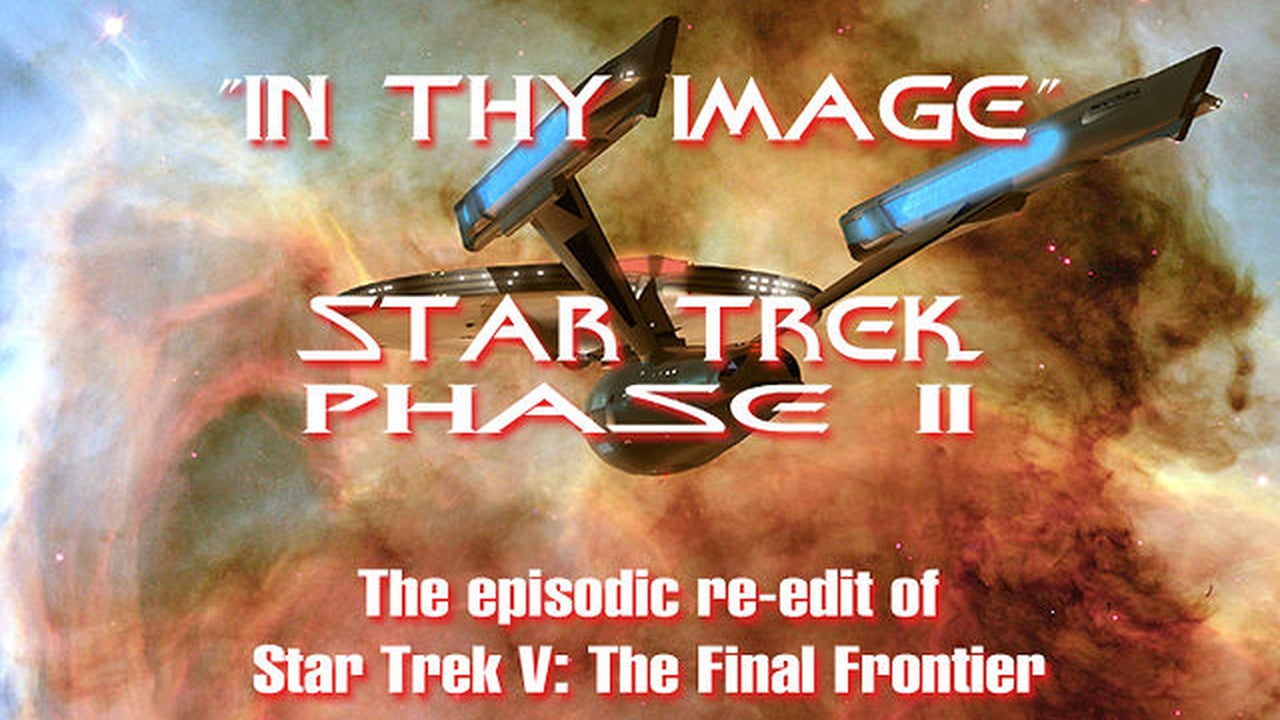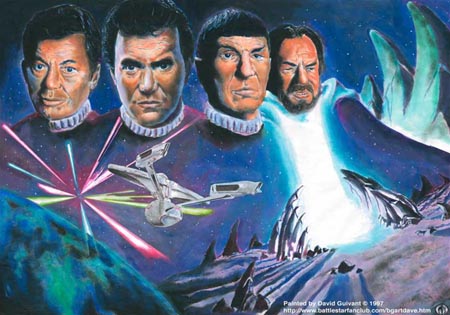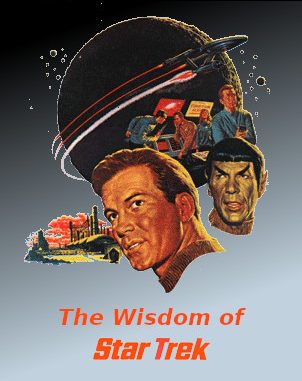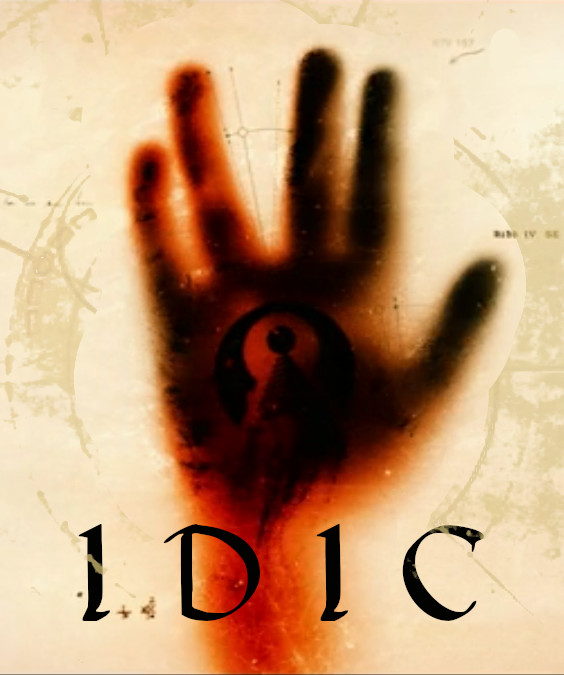| ||||||
| ||||||
|
home
canon
Philosophy of Star Trek:
Integrity
God
IDIC
Resources
Episodes:
|

|
What
is contained herein was the original opening scroll for the re-edited
Trek film. That part no longer exists and is transcribed here. It’s
followed by questions and answers posed by Film Threat’s own,
Chris Gore (www.filmthreat.com). Star Trek Phase II “In Thy Image” Based upon Star Trek V: The Final Frontier In the fall of 1977, Star Trek was poised for a comeback. After being cancelled in 1969, a revival of the series called Star Trek Phase II was planned to begin airing in the fall of 1978 on the then proposed 4th network, The Paramount Network. Sets and props were constructed, screen tests done and several scripts developed including “In Thy Image”, the proposed pilot. The ship was being updated and all but one original cast member, Leonard Nimoy (Spock), had signed on when Paramount pulled the plug. Seeing the success of the previous year’s blockbuster “Star Wars”, the new Trek show was cancelled in favor of creating Star Trek: The Motion Picture. Now, more than 20 years later, Star Trek has released a total of 10 films, and has spawned 4 spin-off series — over 700 hours of storytelling. But had it not been for Star Wars, we would not have the Trek we know today. Had Star Wars not forced Paramount to go with a movie, there would have been no Next Generation, Deep Space Nine, Voyager or Enterprise. Most likely the show would have run for 5 years, then been relegated to syndication, thus ending Trek for good. With over 700 hours of stories, there’s bound to be a few adventures that don’t hit home with the fans. For many this describes Star Trek V The Final Frontier. But for me, I found Trek V to be the movie that most reminded me of the original series with which I had grown up. So, to showcase what I believe to be a much underrated film, I offer this remixed version called: Star Trek Phase II “In Thy Image” — the re-imagined pilot episode of the Lost Trek series. This remixed version of Trek V runs 63 minutes (the same runtime as the original pilot, “The Cage”). The story is broken up into the traditional Trek format of a teaser and five acts. Also, the storyline has been altered, removing those things fans found most objectionable like a certain Vulcan’s new half brother or a turbolift shaft that travels through 78 decks (when we KNOW the ship only has 21 decks total!!) The music score has been enhanced with music from the original series, as well as many classic sound effects such as the bridge ambient noise, the planet background sounds and other effects having been added. In addition, several special effects have been replaced. So, forget what you know about Star Trek. Imagine turning the dial (manually) to September of 1978 to the premiere of the new Trek show. There’s a new ship, the 1701-A, the familiar crew, albeit older and wiser, and when it’s over you realize that this IS Star Trek. An alien convinces a crazy Vulcan that he’s “God”? Crazy Vulcan in turn hijacks the Enterprise and heads for the center of the galaxy with Kirk and company in tow? Kirk stands toe to toe with said alien and kicks his ass? Sounds like an original series episode to me! Enjoy and remember, this is provided as a collector’s oddity only. If you buy it or sell it you’re BREAKING THE LAW. Star Trek is owned by Paramount Pictures and no infringement is intended.
Live Long! Jack Marshall 
I’ve been a fan of varying degree since I was born (the same year as Trek premiered mind you). I suppose I actually became involved in fandom during the early 70’s. In 1976, when Trek and I turned 10, Gene Roddenberry was touring the country doing various conventions. I was fortunate enough to attend one of these shows where I wandered backstage (who sees a kid sneaking by?) and met the man himself. I recall we had a great conversation until some large Romulan babe tried to throw me out. Gene, however, said I could stay and hang out. I spent the rest of the evening backstage with Gene and, in retrospect, that night set the tone for the rest of my life. I wanted to do what he had done — I knew that night that I wanted to be in “the business”.
I really began my career as an actor. At age 8, I was doing theatre and quickly moved on to several regional TV shows. Once I got to college, I discovered an old video editing machine and spent one spring break learning how to use it. When my friends came back from break I forced them to make a music video and I was hooked. I LOVED production and my focus shifted from in front of to behind the camera. After college I moved to L.A., worked on several Hollywood backlots and got a crash course in all aspects of production. About 5 years ago I moved back east where I took a job as producer/director/writer for an educational TV station. It was during this time I was introduced to the digital revolution and won a local Emmy Award to boot! But I’ve never had any “formal” education in film or TV production. I just picked it up along the way. Currently, I spend a lot of time listening to DVD commentary tracks. To me, it’s like sitting through a Master’s level class in film-making.
Originally, I had started work on my version of the Phantom Menace. You see, I had heard about the Phantom Edit, but could never find a copy so I decided to do my own. It was really a case of testing the non-linear editing system that my friend Jerry Yuen and I had built from scratch. So, using the Menace DVD as file footage, I began to run the machine through its paces. About half way through, I thought that this whole process would be so much more satisfying if I could do this using something I loved rather than having to work with a movie I despised. So I turned to Trek.
The
only fans who think Trek V is the worse movie of the franchise are
the ones who haven’t seen Nemesis — but I digress. As I
said, I began looking at Trek for source material and wondered if I
could do anything with my favorite franchise. And you’re
right; most fans seemed to have a certain dislike for Star Trek V.
But I REALLY liked the film. It reminded me of the original series
more than any of the other films. I remember seeing “The
Motion Picture” and leaving the theatre wondering what the hell
happened to the uniforms and where was the ship and crew I had grown
to love over the years. Trek V evoked strong memories of the
original series, and in fact was THE BEST character film of the
franchise. I think a lot of the fans were just very unfair to the
film. In truth, the wrong entity got blamed for Trek V’s
failure — the studio was the enemy, not the director. When I
see Trek V, I see an episode of the original series, and that’s
how the idea began. Overall I spent probably six months working on this. The actual physical editing only took a couple weeks, but the planning and research took a lot longer. As I had mentioned we had just built a non-linear editing machine. My pal Jerry owns a company called Potomac United Network and we spent a lot of time designing and testing the machine. We’re actually in the process of building machine #2 right now. So, a great deal of time was spent developing the technology. Our ultimate goal was and is to build a machine on which we could cut our digital feature.
It's amazing to me that you were able to seamlessly include the original score from the 1960s television series. Can you explain technically how you completed this project? Software used, methods, etc... (And, please, none of this techno-babble like one of the Next Gen movies.) I hate this question because once I answer it, you’ll see how basic it all was to accomplish. I had mentioned that we designed and built a non-linear editing machine. It’s a Pentium P4 1.8 with half a gig of ram, a Canopus DV Storm video editing card, a Creative Audigy 2 digital sound card and a DVD+/- R/RW Sony disc burner. I’ll explain how I managed the technical part of the remix, but for a great resource on everything DVD, check out www.dvdrhelp.com. Using the DVD version of the film, I “ripped” the disc using SmartRipper 2.41. That program copies the DVD to your hard drive. Then using DVD2AVI, I converted the VOB files to AVI’s. Then, those AVI’s are processed with VFAPI Reader. This program converts DVD2AVI projects to fake AVI’s that can be imported into Adobe Premiere. Then, using Adobe Premiere 6.0 and Adobe After Effects 5.5 I treated the files as my own footage and began to re-edit the film from start to finish. Once I had the cut I wanted at the proper length, I went back and started to add “embellishments” such as the original series music and sound effects. These were obtained from the various soundtrack CD’s I own. What’s fortunate is that the Goldsmith score from the movie and the TV score from the 60’s are written IN THE SAME KEY! Therefore, it was easy to move from one piece of music to another. There are times in the remix that we go from music from the 60’s to the Goldsmith score via a cross fade and you absolutely would swear that it’s one piece of music rather than a cobbled together score. Finally, to make it seem more like an episode I wanted to create a unique opening credit sequence as well as a classic looking end credit sequence. The opening sequence is obviously the original opening “Space the final frontier” which leads into a more modern theme written by Dennis McCarthy. The visual you see is actually the beginning of the film “Contact” played in reverse! For the end credits I returned to the original 60’s style credits which used pictures from the episode rather than running the credits on black. The other thing to note is the style in which the acts were broken up. Not only did I want people to clearly understand that we were going from act to act, but I wanted to pay tribute to the original pilot episode, “The Cage” by doing a style similar to what was used before the show ever hit the air. Therefore, between each act there is a graphic saying what act we’re in and what show you’re watching! One other thing I’d like to point out is that I replaced many of the special effects as well. Throughout the film, I used shots from the other movies of the ships wherever possible. One effect in particular I want to point out is the fix of the matte shot of Paradise City. As you can see from the picture comparison, I managed to remove the matte line and match the color with the interior shot that follows.
Unlike the Phantom Menace, which had scenes cut that were just bad, the goal here was to work within the time constraint of a pilot episode. I knew I had to get the movie to 63 minutes (the length of The Cage pilot) if I was indeed going to succeed at creating a TV type show. It came down to the point where I had to decide what was “A” story and had to keep, and could I cut out the “B” and “C” story lines without compromising the meaning of the story that William Shatner was trying to tell. Does Sybok NEED to be Spock’s brother to tell this story? Do Uhura and Scotty HAVE to fall in love? Do the big three HAVE to fly up the turbolift shaft? Is the message demeaned any by cutting the camping scenes? And if I removed these things, would the story remain the same? In my opinion, the story can be told without these elements.
Exactly for that reason. The people don’t like the film see only the things that bother them within it. My goal was not to cut up the film because I didn’t like it - as I’ve said I loved the film. My goal was to re-present the film in a different light so that the fans could see the wonder and power of the story and not get hung up on the little things. It was a terrible mistake of Paramount’s not to give Mr. Shatner the funds he requested to do a Director’s Edition of the film. From a business stand point, they would have sold more than enough DVD’s to cover the cost. The “Special Edition” they have coming out is the same film that was released and fans will not buy it. I created this re-mix so that fans could re-visit the story and see it in a new light.
I don’t see this as “editing skill” as much as I see this as producing and directing during the editing process. In this case, I worked the machine myself, but there are others who could work the hardware better than I. I really consider myself a vision person, a director/producer type rather than an editor. So with that in mind, I’d just like to take what I’ve done to the next level and would just be happy getting paid for doing this the next time.
I’m getting geared up to direct my first feature. When Shatner directed this movie, it was his first time as a feature director as well. Being on the set your whole life does not necessarily mean you can step up to the director’s plate. Shatner did, and for a first film did a tremendous job with a subject that is very difficult to handle. In reading his “Making of” book, I’m amazed at the similarity between the problems he encountered and those that I am currently facing in my own project and career. Granted his budget was WAY different than mine is, but the fact is, a first timer is a first timer. I admire anyone who’s willing to put their reputation on the line for something they believe in and still admire the man to this day. Shatner had great vision for his film — he seemed to want to make an epic in the vein of Lawrence of Arabia, but Paramount wanted something different. I hope that he understands that the remix is not a slam. I wrote Shatner a letter after I had seen the film a dozen times the summer it came out (1989). He even responded, by the way! The point is, when I saw this movie, it was at a time in my life that I needed to hear the message it was saying. I think it’s a great film and I have nothing but love for what he accomplished! The fact is, the movie made a difference in my life in some small way and I hope he knows that I’m grateful to him for that.
Most people can’t believe what they’ve seen, nor do they understand the process that went into making it. But everyone has said the same thing — “it’s like watching a lost episode of the original series”. That was my goal — so I guess it’s worked.
I don’t think its Berman’s fault per se. It’s the business mentality that’s at fault. Paramount handles Trek as a business (as it should) and, although I disagree with how they’re running it, what can you do? I’ve tried to contribute to Trek by doing the remix, and hope to continue to contribute. Paramount thought dropping the Star Trek brand name from Enterprise was the way to go. I think that speaks volumes! I realize it’s a business, I know they are making economic decisions — I’m not crying as a fan saying they aren’t doing Trek well, I’m saying they are handling their business poorly. They are trying to sell a new Trek when the majority of people want old Trek — Roddenberry Trek if you will. Paramount’s afraid to give the franchise to a fan because they know we don’t care about the one thing that is most important — demographics. Enterprise doesn’t appeal to me on many levels but Paramount doesn’t care — you know why? — Because I’m not 18-24 years old. Business tells us to cater to that demographic because that’s the demographic that buys stuff. Classic Trek however wasn’t about demographics. Children, bums, scientists, factory workers — it appealed to everyone. A Trek episode from the 60’s has much more playability than anything else that has carried the brand name. As a child I watched Trek for the action. As an adult, I notice that I have different favorite episodes than when I was a child. Classic Trek is timeless, but I can’t see watching reruns of Enterprise 35 years from now. The guys who ran DS9 would be GREAT as the heads of Trek. They were shining examples of what fans could do for the franchise.
It comes down to this. The part of T’Pol came down to two actors – Jolene Blalock who got the part and Marjorie Monohan who didn’t. Majorie, who I happened to go to high school with, would have rivaled Spock as the epitome of a Vulcan. She was the perfect choice — teamed with Bacula, she would have been a formidable cast member. You may know Marjorie from Babylon 5 as Number 1 and from Space Rangers. Instead, we got the tits. That’s the wrong choice. It’s not what Trek is about. OK there were tits in Star Trek, but it was backed by brains and brawn — not cover girl acting. It breaks my heart that Marjorie didn’t get the part, but it makes sense. Trek is playing to the lowest denominator now rather than trying to grow its fan base. They are courting the wrestling crowd rather than the group the show captured in the 70’s and 80’s. I’d love to take a shot at the franchise. I’m not saying I could save Trek, but I know for a fact I would steer the ship in a different direction — radically different.
I do hope that people can find a copy and check it out. It was a real joy to do and I still watch it myself (although you can imagine how many times I’ve seen it just during the editing process). Perhaps the greatest aspect of doing the remix has been sharing it with fans who appreciate the “classic Trek” touches and the discussions that ensue. It’s opened many doors for me, but more importantly, it has made me feel that I’ve made a difference in the life of Star Trek as it has made a difference in mine.
Jack Marshall jack@5yearmission.com www.5yearmission.com |
|
Return to The wisdom of |
 |
 |
 |